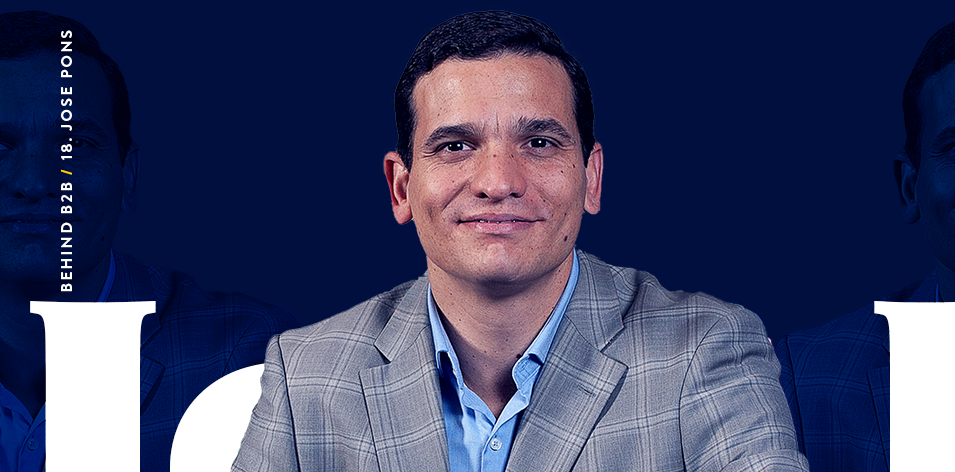

For the 18th instalment of Behind B2B, we’re speaking to José Pons, Head of Product & B2B Marketing Europe at Visa.
As many of us know, sales and marketing don’t always see eye to eye. But for a leader like José, knitting the two together comes naturally. We sat down with Visa’s Head of Product and B2B Marketing Europe to hear how having one foot in both worlds helps him drive results for a major global brand.
When I was a kid, I actually wanted to be a lawyer – I was obsessed with those US legal dramas. But candidly, I also had a real passion for sales. When I was seven years old, my mom went on a business trip, and I took the opportunity to make some money. I went knocking on doors all around the neighbourhood to sell my toys, along with a range of small items from our house. As you can imagine, my mom was not impressed – I had to spend a long time circling back to recover all the items from my neighbours!
But I always had that drive to sell. I built a couple of parallel businesses as a teen: washing cars, selling pictures that I drew. I think if I was a kid today, I would’ve been selling through TikTok! So unsurprisingly, I went on to study Business at University and then ended up in sales. And now, when someone asks how I define myself, I say I’m a business marketer.
It’s funny. I’ve often thought I’m too sales-driven for marketers and too marketing-driven for salespeople. But that’s why I found my home in B2B, because it’s this perfect balance of a revenue-focused approach, but still with creativity and strategic thinking. It’s the best of both worlds, from my perspective.
As for the journey: I started my career in a family business. My father had a business manufacturing sauces, and I worked there as a salesperson for a few years. Later, I worked with Kimberly Clark for almost 9 years, mainly in the consumer business.
Then, I was invited to be part of a company called Grupo QBCo by my former manager from KC, who moved there to become its President. Grupo QBCo’s focus was producing private label condiments for big retailers and FMCG distributors. So I’d moved from this company managing well-established brands, competing against private labels – and now I was leading the sales and marketing team for a private label company, trying to convince retailers to take on new lines.
This was really where my B2B marketing journey began. We had to do a lot of work reinventing the company’s value proposition and developing the marketing strategy in a way that aligned with sales execution. It was high stakes – every bottle we sold back then felt like the difference between being able to pay salaries and not. That meant we never lost sight of our end goal.
I’ve been working at the intersection of B2B marketing and sales ever since. I moved to Visa in 2018, which has been a fantastic experience. Very different to what I’ve done before but a great opportunity to put everything I’ve learnt into practice. Overall, I’ve definitely felt the benefit of having worked in sales and marketing. I know fundamentally that in business, everything you do should be to deliver value for your clients – and through that, to generate incremental sales.
I was working at a recently created company in Latin America, which had the ambition to become the biggest Private Label manufacturer in the region. But we faced a massive challenge, because these brands are far less developed than in other continents. In Europe, private labels have 45 to 50% market share among big retailers. In Latin America, it was more like 10%. The big, established brands have a lot of strong negotiation power with the retailers, whereas private labels don’t.
So to drive our growth, we took a holistic approach. It wasn’t a particular campaign or initiative that I’m proud of, it was the complete modelling of a B2B strategy. We began with the value proposition, working to understand the consumer and their behaviours in detail to make recommendations to our retailing customers. That’s so important in B2B. You have to understand that your clients have their clients, so you need to comprehend the complete journey, the complete value chain.
We started to shift the private label paradigm. Instead of just looking at selling cheaper products, we looked at the value they could create and their growth potential. Then, we took the value proposition and tested it, seeing how we’d bring it to life in a go-to-market plan and execute it completely in a real sales environment.
We innovated. We satisfied our customers’ needs by helping them to satisfy their client needs. We built our strategic lines, developed new ones, and tried new things to generate more value for our clients. But we always, always looped back to that early marketing work of the value prop.
The result of working in that holistic way? In less than five years, we almost tripled the business, significantly improved our NPS scores, and built fantastic customer relationships. It’s a real case study of how marketing and sales can and should work together.
I can’t say it enough: a holistic approach. Marketing campaigns can’t be produced and deployed in isolation: everything has to be embedded in the Go To Market model. Every step has to follow something else, from the genesis of the product to the sales cycle.
I’m also a firm believer in brand purpose – but it has to align with the values and the actions of the company. Harnessed in the right way, brand purpose is very powerful for marketing.
And finally, innovation and creativity. Creativity is such an important component of every problem. Doing things differently, while ensuring that your version of ‘different’ is grounded in strategy and research. Maybe you take the same message and execute through a different channel; maybe you reach the same audience in a different way.
I think Hewlett Packard did an exceptional job during the early days of the pandemic, promoting 3D printers. They enabled clients to use their kit to do things like manufacturing the components for ventilators. It was really impressive; they drew the company together to build the blueprints for the parts, reached out to medical institutions, and tried to solve a problem that was a top priority for the world.
And of course, the marketing was there to ensure the reach was as wide as possible. They put their technical skill and B2B marketing capabilities at the service of the medical community, in a way that was totally aligned with their brand purpose.
First: neglecting creativity. Creativity and innovation are essential, integral parts of what we do. If we do what we’ve always done, we’ll get the same results. There’s no excuse for it, especially since we have the technological capabilities to really reach our audiences in exciting ways.
The second is the flip side of brand purpose. We’ve talked about how powerful brand purpose is, but if your marketing efforts aren’t aligned to your brand purpose: what’s the point? You have to be consistent and it has to make sense, just like the HP example.
It’s not easy. But all around us, there are proof points of how powerful great purpose and a meaningful, holistic approach to B2B marketing and sales can be.
The latest (and most useful) B2B insight, delivered to your inbox.
Publicis Pro needs the contact information you provide to send you the latest B2B insights. You may unsubscribe from these communications at anytime.